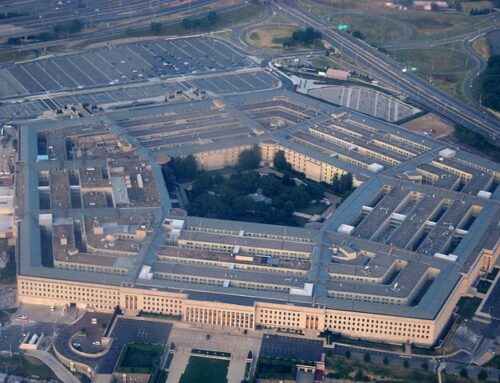The Senate Armed Services Committee and House Armed Services Committee have each released a summary of actions taken by the conference committee crafting the final version of the Pentagon policy bill for Fiscal Year 2018 (FY18).
The National Defense Authorization Act (NDAA) is a policy bill, once it is signed into law by the president it will not cause a single one of your tax dollars to be spent. Only the Defense Appropriations bill can do that. So while many of the provisions of the NDAA are fiscally irresponsible, such as the topline of $700 billion when the Budget Control Act of 2011 caps defense spending at $549 billion in FY18, we won’t yammer on about them.
Okay, just a little yammering – the authorizers sure like to try to force the Pentagon to buy things it didn’t ask for. Just a small sample from the aircraft procurement section of the bill:
- 90 F-35s rather than the “mere” 70 the Trump Administration asked for
- 17 KC-46A tankers versus the 15 in the request
- 11 MC-130Js versus the 5 in the request
- 24 F/A-18 Super Hornets versus the 14 in the request
- 10 P-8 Poseidons rather than the 7 in the request
- 12 V-22 Ospreys versus the 6 in the request
That’s just the publicly available increases in the aircraft programs. If you click on either of the links to the summary, you’ll find plenty of other increases in the ship, ground combat, and other weapon system accounts.
But if you’re reading the details and adding things up, as we like to do at TCS, that’s a whopping 37 aircraft more than the Pentagon asked for at an additional cost of at least $7.9 billion.
There’s also a provision authorizing $30 million for the Navy to explore a new “small” aircraft carrier. The Navy has explored, and rejected, this idea in the recent past but no bad idea is ever actually dead in Washington. And if the appropriations bill puts real money against this idea, the fiscally-minded among us will have a hard time killing it this time. Once an idea has seed money, a constituency quickly follows.
Again, this bill doesn’t actually give the Pentagon any money to buy these additional aircraft or a small aircraft carrier. But the conference report for the NDAA is avidly read by every defense contractor in the country as well as officials in the Pentagon. And the conference report is a powerful signal of where the Congress wants money to eventually flow. If you close your eyes you can imagine the stampede of lobbyists for the major defense contractors bearing down on the Appropriations Committees to pursue the money to fulfill the “requirements” of the NDAA.
Now, in the area where the NDAA actually can make law, the bill requires the Air Force “to maintain a minimum fighter aircraft inventory.” Sigh. Because, evidently, the Air Force doesn’t really know what it needs to fight the nation’s wars.
Another provision expands the National Sea-based Deterrence Fund to include an authority for multiyear procurement of critical components. We’ve written a lot about this bad idea, so we’ll summarize here: the Navy should buy the next ballistic missile submarine from its own budget, not some magic pot of money in the Office of the Secretary of Defense. And, allowing for the purchase of critical materials in advance of the authorization of a specific number of submarines is just a sneaky way of trying to insulate the program from future cuts in the number of hulls. Bad idea piled on top of bad idea. Thus far the Appropriations Committees have been the bulwark against this end-around and we will be encouraging them to maintain their more fiscally responsible stance. We certainly hope the appropriators won’t believe the rhetorical flourish in the House Armed Services Committee’s press release that this authority will save “several hundred million dollars with each submarine and aircraft carrier.” (Bolding in original.) Again, what buying the long lead items really does is lock in future Congresses to purchasing a given number of submarines or carriers. At Taxpayers, we’re all for letting a future Congress make the, hopefully, wisest decision when they actually approve the individual submarine or carrier.
There is evidently some bill language, briefly summarized in the Senate press release, that “fully supports the modernization of the nuclear triad.” Well, the Congressional Budget Office just estimated that this program of building new subs, bombers, and missiles will cost $1.2 trillion over 30 years. So, again, the Appropriations Committees will have to figure out how to do that without blowing a hole in future budgets.
One more thing. There seems to be yet another sack of money being slung at the military to “reassure NATO allies.” This one is called the European Deterrence Initiative (EDI), and the bill authorizes $4.6 billion for it. In the fiscal year 2015 NDAA, EDI joined the “European Reassurance Initiative” another multi-billion dollar program. Call us crazy, but wouldn’t simply increasing our commitment to NATO in the old-fashioned way be effective? These two programs smack of looking for ways to raise the topline of the bill to $700 billion so everyone can write a press release saying they just voted for $700 billion for the Pentagon.
We are pleased to see the Senate press release indicate that laws and regulations “that limit DOD from obtaining the best value to the government” are reduced in the final version of the bill. We hope that means the sunsetting of certain anti-competitive “Buy American” provisions was codified in the NDAA. If so, that’s a win for taxpayers.
Overall, there is very little to cheer in these synopses of what is in the authorization bill. We’ll be poring through the actual bill and report language once it’s released and continue writing about it.











Get Social